Strategic Management Report: Grain Corp Limited's Global Expansion
VerifiedAdded on 2022/11/03
|10
|3036
|119
Report
AI Summary
This report provides a comprehensive strategic analysis of Grain Corp Limited, an Australian grain-focused agribusiness. It begins with an overview of the Australian grain industry, highlighting its contribution to the GDP and its global significance, including the use of technology and sustainable practices. The report then identifies international opportunities for Grain Corp, particularly in emerging markets where demand for high-quality grains is increasing. It discusses various international strategies, such as partnerships, digital marketing, optimized supply chains, low-cost strategies, and product diversification, to achieve success in these markets. The report also evaluates different modes of entry, concluding that export with local partners is the most appropriate strategy, while wholly owned subsidiaries are the least suitable. Finally, the report offers recommendations for Grain Corp's future strategic direction, emphasizing the importance of adapting to changing market dynamics and leveraging its strengths in the global arena.
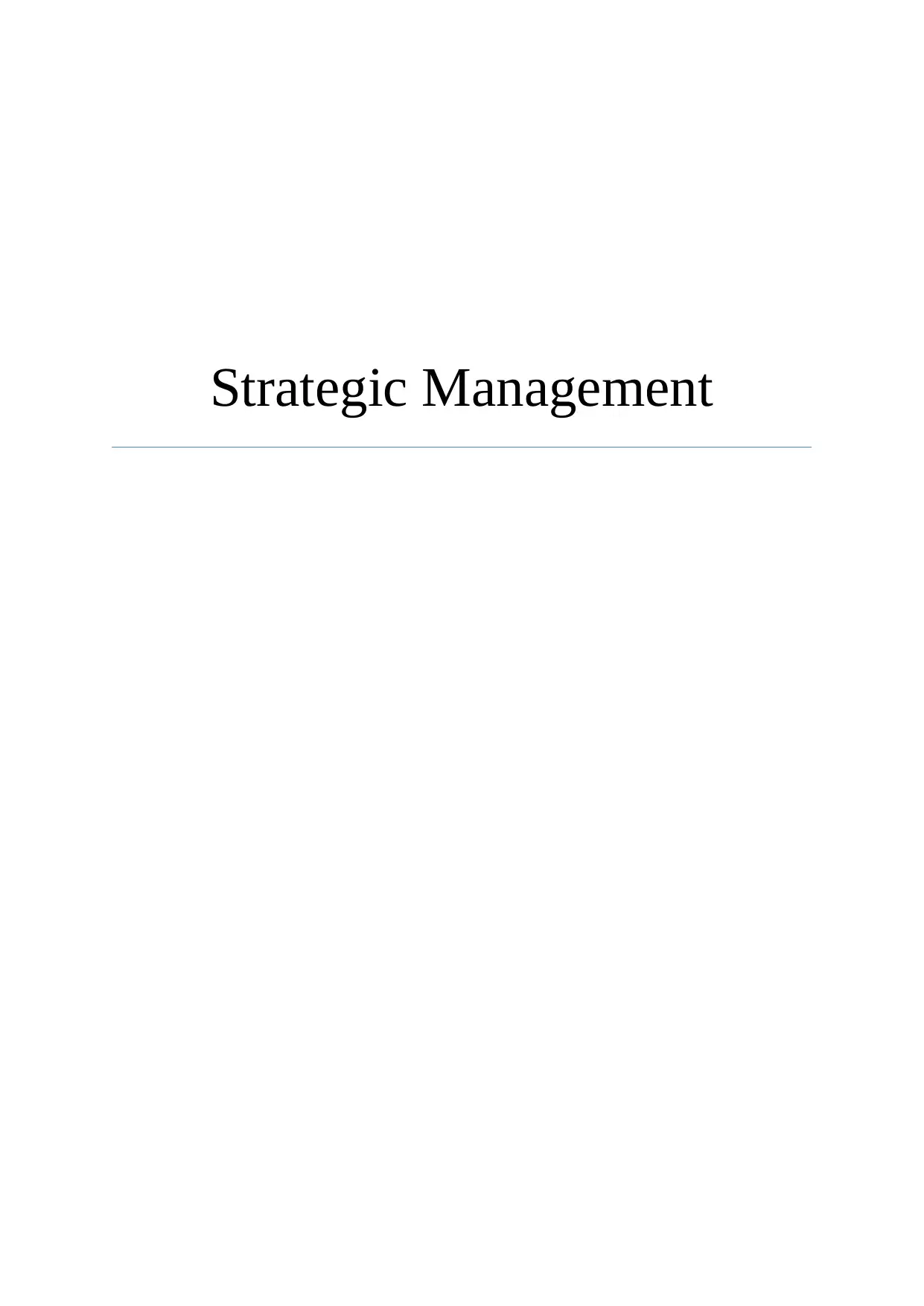
Strategic Management
Paraphrase This Document
Need a fresh take? Get an instant paraphrase of this document with our AI Paraphraser
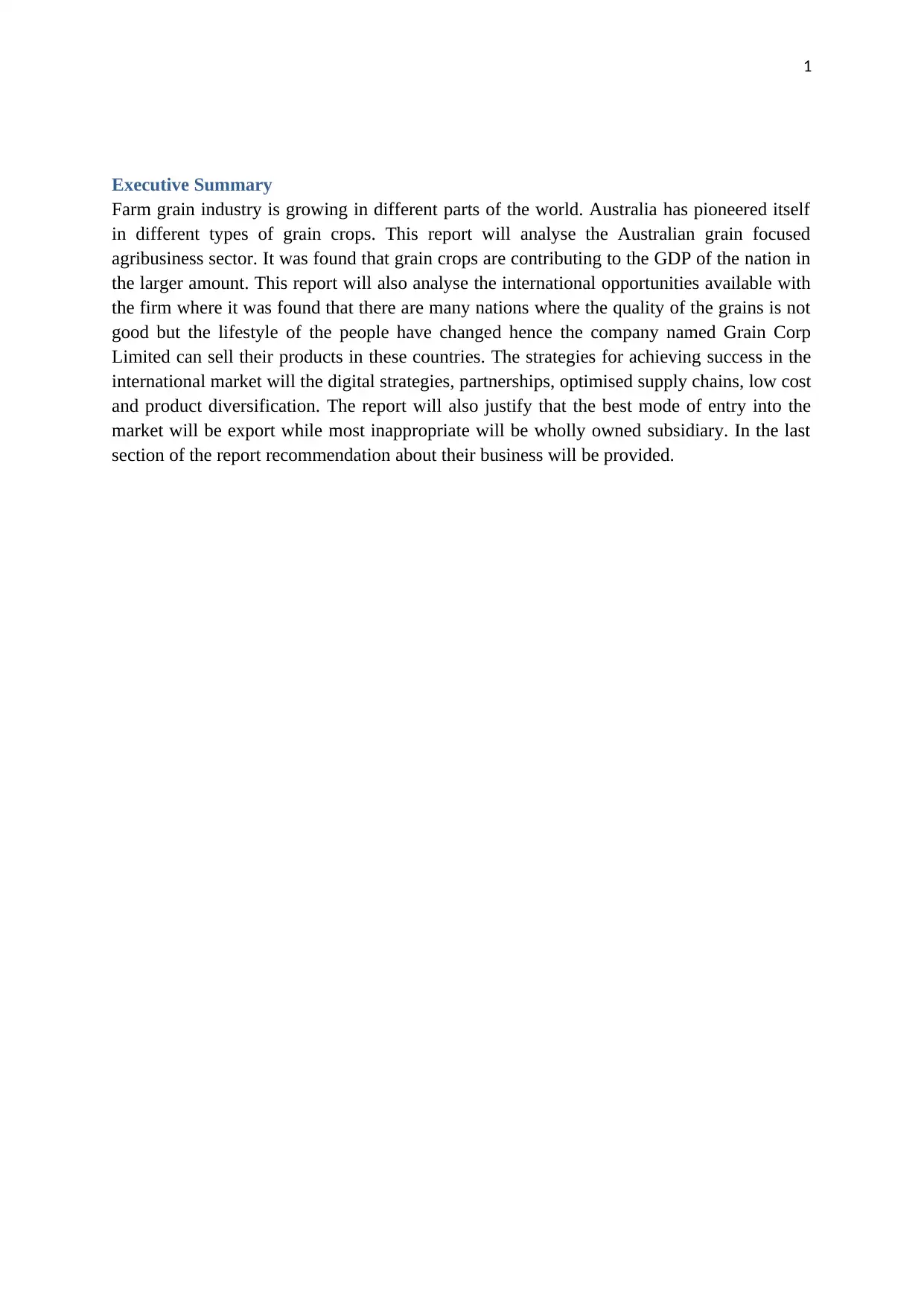
1
Executive Summary
Farm grain industry is growing in different parts of the world. Australia has pioneered itself
in different types of grain crops. This report will analyse the Australian grain focused
agribusiness sector. It was found that grain crops are contributing to the GDP of the nation in
the larger amount. This report will also analyse the international opportunities available with
the firm where it was found that there are many nations where the quality of the grains is not
good but the lifestyle of the people have changed hence the company named Grain Corp
Limited can sell their products in these countries. The strategies for achieving success in the
international market will the digital strategies, partnerships, optimised supply chains, low cost
and product diversification. The report will also justify that the best mode of entry into the
market will be export while most inappropriate will be wholly owned subsidiary. In the last
section of the report recommendation about their business will be provided.
Executive Summary
Farm grain industry is growing in different parts of the world. Australia has pioneered itself
in different types of grain crops. This report will analyse the Australian grain focused
agribusiness sector. It was found that grain crops are contributing to the GDP of the nation in
the larger amount. This report will also analyse the international opportunities available with
the firm where it was found that there are many nations where the quality of the grains is not
good but the lifestyle of the people have changed hence the company named Grain Corp
Limited can sell their products in these countries. The strategies for achieving success in the
international market will the digital strategies, partnerships, optimised supply chains, low cost
and product diversification. The report will also justify that the best mode of entry into the
market will be export while most inappropriate will be wholly owned subsidiary. In the last
section of the report recommendation about their business will be provided.
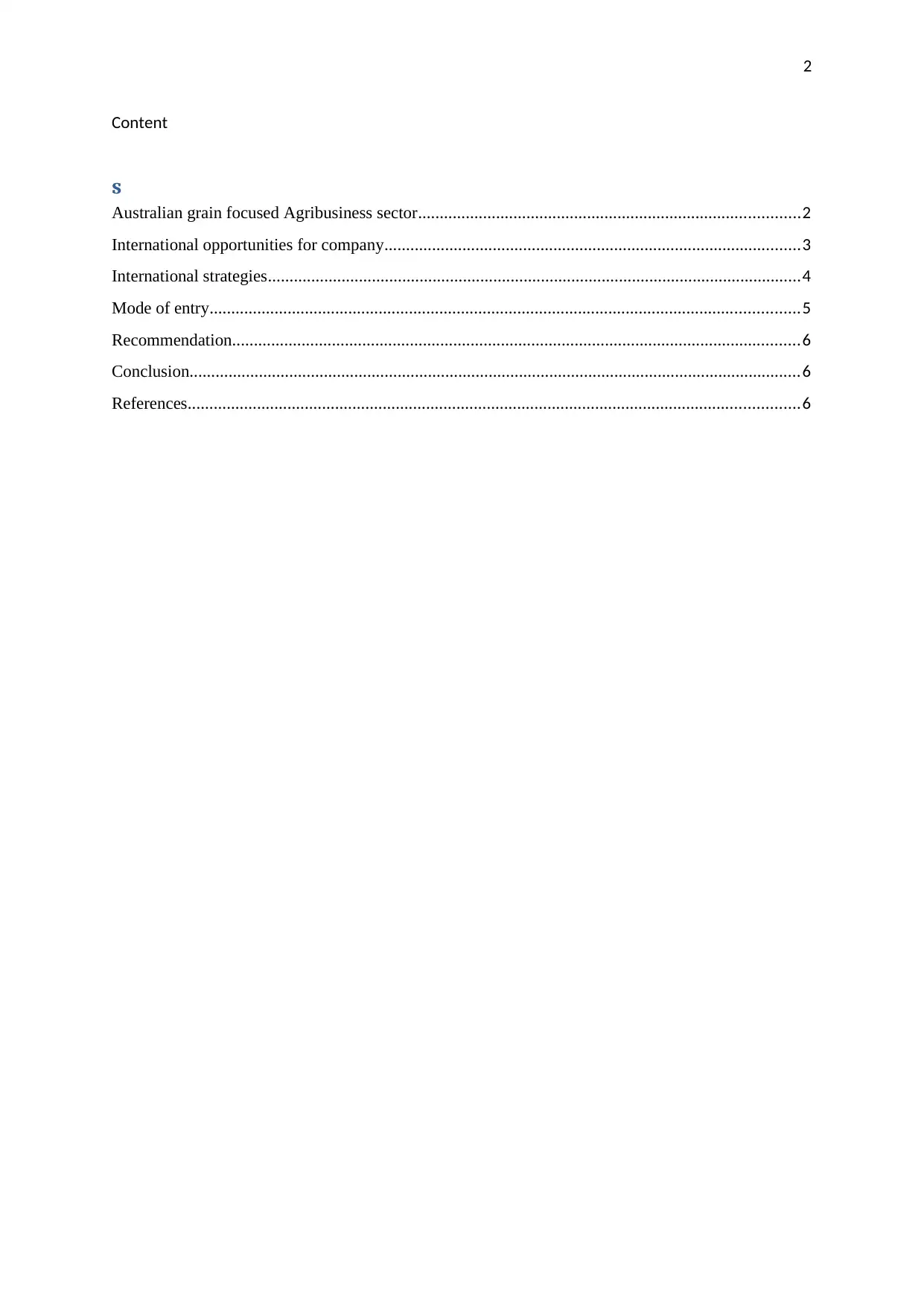
2
Content
s
Australian grain focused Agribusiness sector........................................................................................2
International opportunities for company................................................................................................3
International strategies...........................................................................................................................4
Mode of entry........................................................................................................................................5
Recommendation...................................................................................................................................6
Conclusion.............................................................................................................................................6
References.............................................................................................................................................6
Content
s
Australian grain focused Agribusiness sector........................................................................................2
International opportunities for company................................................................................................3
International strategies...........................................................................................................................4
Mode of entry........................................................................................................................................5
Recommendation...................................................................................................................................6
Conclusion.............................................................................................................................................6
References.............................................................................................................................................6
⊘ This is a preview!⊘
Do you want full access?
Subscribe today to unlock all pages.

Trusted by 1+ million students worldwide
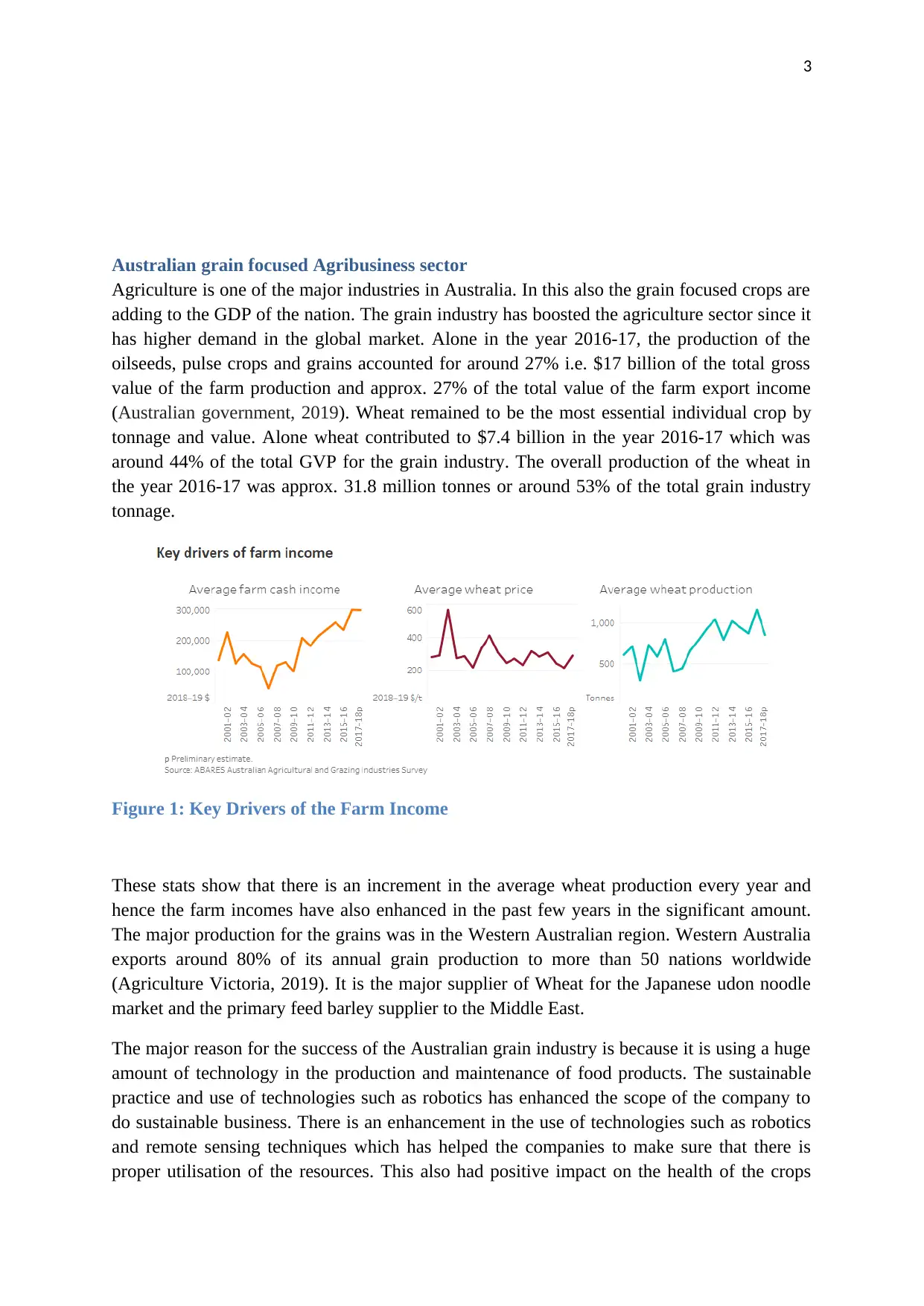
3
Australian grain focused Agribusiness sector
Agriculture is one of the major industries in Australia. In this also the grain focused crops are
adding to the GDP of the nation. The grain industry has boosted the agriculture sector since it
has higher demand in the global market. Alone in the year 2016-17, the production of the
oilseeds, pulse crops and grains accounted for around 27% i.e. $17 billion of the total gross
value of the farm production and approx. 27% of the total value of the farm export income
(Australian government, 2019). Wheat remained to be the most essential individual crop by
tonnage and value. Alone wheat contributed to $7.4 billion in the year 2016-17 which was
around 44% of the total GVP for the grain industry. The overall production of the wheat in
the year 2016-17 was approx. 31.8 million tonnes or around 53% of the total grain industry
tonnage.
Figure 1: Key Drivers of the Farm Income
These stats show that there is an increment in the average wheat production every year and
hence the farm incomes have also enhanced in the past few years in the significant amount.
The major production for the grains was in the Western Australian region. Western Australia
exports around 80% of its annual grain production to more than 50 nations worldwide
(Agriculture Victoria, 2019). It is the major supplier of Wheat for the Japanese udon noodle
market and the primary feed barley supplier to the Middle East.
The major reason for the success of the Australian grain industry is because it is using a huge
amount of technology in the production and maintenance of food products. The sustainable
practice and use of technologies such as robotics has enhanced the scope of the company to
do sustainable business. There is an enhancement in the use of technologies such as robotics
and remote sensing techniques which has helped the companies to make sure that there is
proper utilisation of the resources. This also had positive impact on the health of the crops
Australian grain focused Agribusiness sector
Agriculture is one of the major industries in Australia. In this also the grain focused crops are
adding to the GDP of the nation. The grain industry has boosted the agriculture sector since it
has higher demand in the global market. Alone in the year 2016-17, the production of the
oilseeds, pulse crops and grains accounted for around 27% i.e. $17 billion of the total gross
value of the farm production and approx. 27% of the total value of the farm export income
(Australian government, 2019). Wheat remained to be the most essential individual crop by
tonnage and value. Alone wheat contributed to $7.4 billion in the year 2016-17 which was
around 44% of the total GVP for the grain industry. The overall production of the wheat in
the year 2016-17 was approx. 31.8 million tonnes or around 53% of the total grain industry
tonnage.
Figure 1: Key Drivers of the Farm Income
These stats show that there is an increment in the average wheat production every year and
hence the farm incomes have also enhanced in the past few years in the significant amount.
The major production for the grains was in the Western Australian region. Western Australia
exports around 80% of its annual grain production to more than 50 nations worldwide
(Agriculture Victoria, 2019). It is the major supplier of Wheat for the Japanese udon noodle
market and the primary feed barley supplier to the Middle East.
The major reason for the success of the Australian grain industry is because it is using a huge
amount of technology in the production and maintenance of food products. The sustainable
practice and use of technologies such as robotics has enhanced the scope of the company to
do sustainable business. There is an enhancement in the use of technologies such as robotics
and remote sensing techniques which has helped the companies to make sure that there is
proper utilisation of the resources. This also had positive impact on the health of the crops
Paraphrase This Document
Need a fresh take? Get an instant paraphrase of this document with our AI Paraphraser
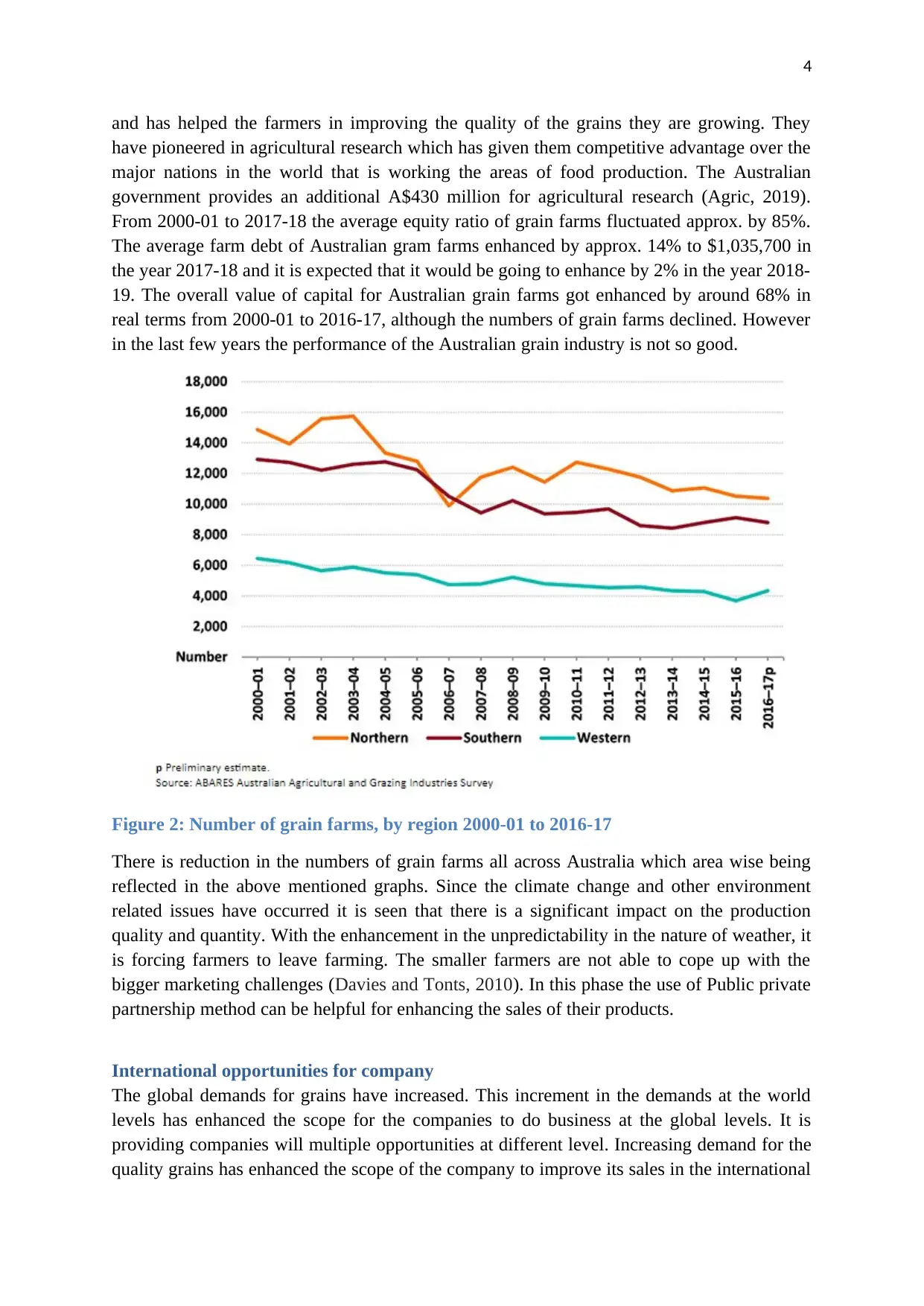
4
and has helped the farmers in improving the quality of the grains they are growing. They
have pioneered in agricultural research which has given them competitive advantage over the
major nations in the world that is working the areas of food production. The Australian
government provides an additional A$430 million for agricultural research (Agric, 2019).
From 2000-01 to 2017-18 the average equity ratio of grain farms fluctuated approx. by 85%.
The average farm debt of Australian gram farms enhanced by approx. 14% to $1,035,700 in
the year 2017-18 and it is expected that it would be going to enhance by 2% in the year 2018-
19. The overall value of capital for Australian grain farms got enhanced by around 68% in
real terms from 2000-01 to 2016-17, although the numbers of grain farms declined. However
in the last few years the performance of the Australian grain industry is not so good.
Figure 2: Number of grain farms, by region 2000-01 to 2016-17
There is reduction in the numbers of grain farms all across Australia which area wise being
reflected in the above mentioned graphs. Since the climate change and other environment
related issues have occurred it is seen that there is a significant impact on the production
quality and quantity. With the enhancement in the unpredictability in the nature of weather, it
is forcing farmers to leave farming. The smaller farmers are not able to cope up with the
bigger marketing challenges (Davies and Tonts, 2010). In this phase the use of Public private
partnership method can be helpful for enhancing the sales of their products.
International opportunities for company
The global demands for grains have increased. This increment in the demands at the world
levels has enhanced the scope for the companies to do business at the global levels. It is
providing companies will multiple opportunities at different level. Increasing demand for the
quality grains has enhanced the scope of the company to improve its sales in the international
and has helped the farmers in improving the quality of the grains they are growing. They
have pioneered in agricultural research which has given them competitive advantage over the
major nations in the world that is working the areas of food production. The Australian
government provides an additional A$430 million for agricultural research (Agric, 2019).
From 2000-01 to 2017-18 the average equity ratio of grain farms fluctuated approx. by 85%.
The average farm debt of Australian gram farms enhanced by approx. 14% to $1,035,700 in
the year 2017-18 and it is expected that it would be going to enhance by 2% in the year 2018-
19. The overall value of capital for Australian grain farms got enhanced by around 68% in
real terms from 2000-01 to 2016-17, although the numbers of grain farms declined. However
in the last few years the performance of the Australian grain industry is not so good.
Figure 2: Number of grain farms, by region 2000-01 to 2016-17
There is reduction in the numbers of grain farms all across Australia which area wise being
reflected in the above mentioned graphs. Since the climate change and other environment
related issues have occurred it is seen that there is a significant impact on the production
quality and quantity. With the enhancement in the unpredictability in the nature of weather, it
is forcing farmers to leave farming. The smaller farmers are not able to cope up with the
bigger marketing challenges (Davies and Tonts, 2010). In this phase the use of Public private
partnership method can be helpful for enhancing the sales of their products.
International opportunities for company
The global demands for grains have increased. This increment in the demands at the world
levels has enhanced the scope for the companies to do business at the global levels. It is
providing companies will multiple opportunities at different level. Increasing demand for the
quality grains has enhanced the scope of the company to improve its sales in the international
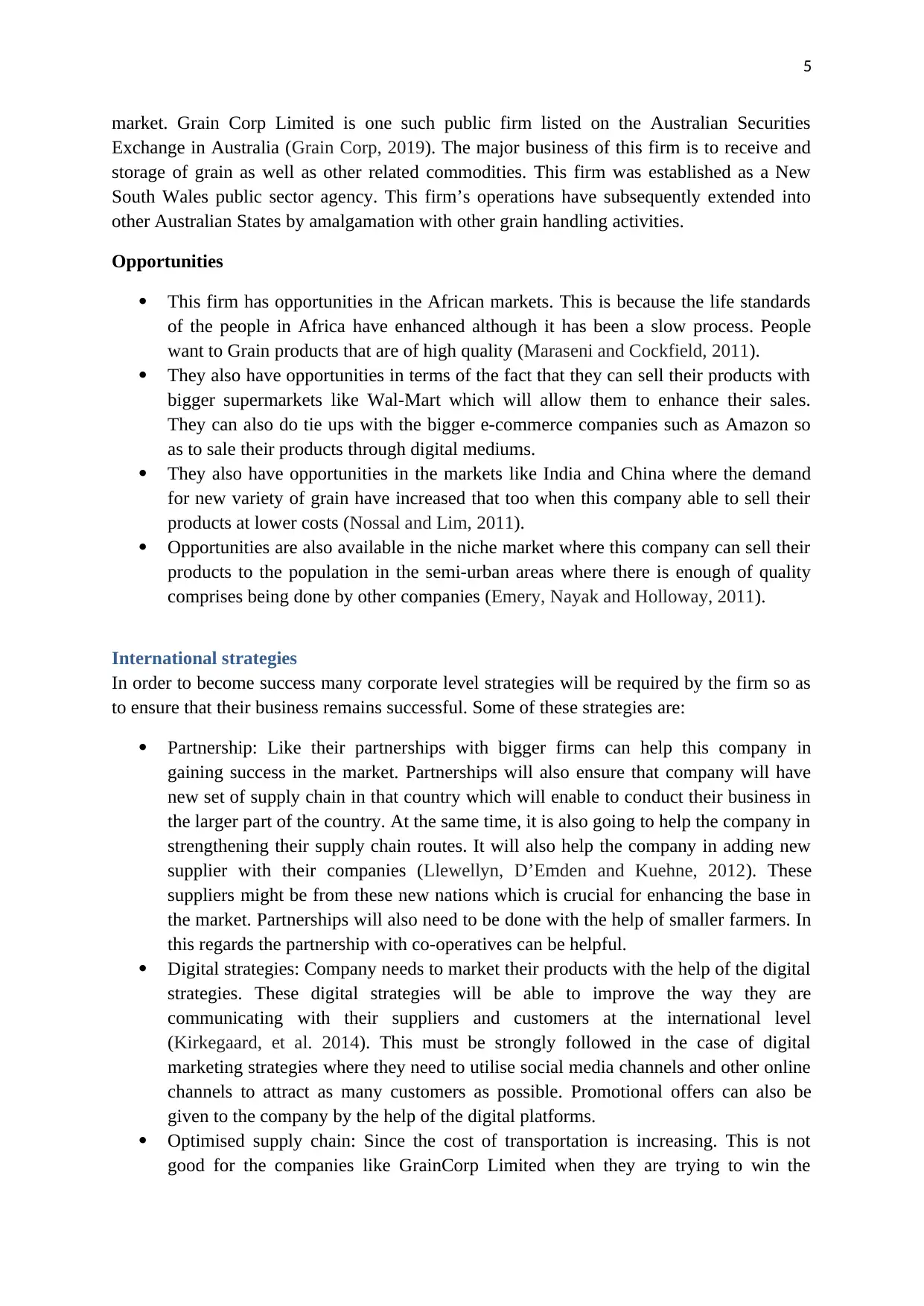
5
market. Grain Corp Limited is one such public firm listed on the Australian Securities
Exchange in Australia (Grain Corp, 2019). The major business of this firm is to receive and
storage of grain as well as other related commodities. This firm was established as a New
South Wales public sector agency. This firm’s operations have subsequently extended into
other Australian States by amalgamation with other grain handling activities.
Opportunities
This firm has opportunities in the African markets. This is because the life standards
of the people in Africa have enhanced although it has been a slow process. People
want to Grain products that are of high quality (Maraseni and Cockfield, 2011).
They also have opportunities in terms of the fact that they can sell their products with
bigger supermarkets like Wal-Mart which will allow them to enhance their sales.
They can also do tie ups with the bigger e-commerce companies such as Amazon so
as to sale their products through digital mediums.
They also have opportunities in the markets like India and China where the demand
for new variety of grain have increased that too when this company able to sell their
products at lower costs (Nossal and Lim, 2011).
Opportunities are also available in the niche market where this company can sell their
products to the population in the semi-urban areas where there is enough of quality
comprises being done by other companies (Emery, Nayak and Holloway, 2011).
International strategies
In order to become success many corporate level strategies will be required by the firm so as
to ensure that their business remains successful. Some of these strategies are:
Partnership: Like their partnerships with bigger firms can help this company in
gaining success in the market. Partnerships will also ensure that company will have
new set of supply chain in that country which will enable to conduct their business in
the larger part of the country. At the same time, it is also going to help the company in
strengthening their supply chain routes. It will also help the company in adding new
supplier with their companies (Llewellyn, D’Emden and Kuehne, 2012). These
suppliers might be from these new nations which is crucial for enhancing the base in
the market. Partnerships will also need to be done with the help of smaller farmers. In
this regards the partnership with co-operatives can be helpful.
Digital strategies: Company needs to market their products with the help of the digital
strategies. These digital strategies will be able to improve the way they are
communicating with their suppliers and customers at the international level
(Kirkegaard, et al. 2014). This must be strongly followed in the case of digital
marketing strategies where they need to utilise social media channels and other online
channels to attract as many customers as possible. Promotional offers can also be
given to the company by the help of the digital platforms.
Optimised supply chain: Since the cost of transportation is increasing. This is not
good for the companies like GrainCorp Limited when they are trying to win the
market. Grain Corp Limited is one such public firm listed on the Australian Securities
Exchange in Australia (Grain Corp, 2019). The major business of this firm is to receive and
storage of grain as well as other related commodities. This firm was established as a New
South Wales public sector agency. This firm’s operations have subsequently extended into
other Australian States by amalgamation with other grain handling activities.
Opportunities
This firm has opportunities in the African markets. This is because the life standards
of the people in Africa have enhanced although it has been a slow process. People
want to Grain products that are of high quality (Maraseni and Cockfield, 2011).
They also have opportunities in terms of the fact that they can sell their products with
bigger supermarkets like Wal-Mart which will allow them to enhance their sales.
They can also do tie ups with the bigger e-commerce companies such as Amazon so
as to sale their products through digital mediums.
They also have opportunities in the markets like India and China where the demand
for new variety of grain have increased that too when this company able to sell their
products at lower costs (Nossal and Lim, 2011).
Opportunities are also available in the niche market where this company can sell their
products to the population in the semi-urban areas where there is enough of quality
comprises being done by other companies (Emery, Nayak and Holloway, 2011).
International strategies
In order to become success many corporate level strategies will be required by the firm so as
to ensure that their business remains successful. Some of these strategies are:
Partnership: Like their partnerships with bigger firms can help this company in
gaining success in the market. Partnerships will also ensure that company will have
new set of supply chain in that country which will enable to conduct their business in
the larger part of the country. At the same time, it is also going to help the company in
strengthening their supply chain routes. It will also help the company in adding new
supplier with their companies (Llewellyn, D’Emden and Kuehne, 2012). These
suppliers might be from these new nations which is crucial for enhancing the base in
the market. Partnerships will also need to be done with the help of smaller farmers. In
this regards the partnership with co-operatives can be helpful.
Digital strategies: Company needs to market their products with the help of the digital
strategies. These digital strategies will be able to improve the way they are
communicating with their suppliers and customers at the international level
(Kirkegaard, et al. 2014). This must be strongly followed in the case of digital
marketing strategies where they need to utilise social media channels and other online
channels to attract as many customers as possible. Promotional offers can also be
given to the company by the help of the digital platforms.
Optimised supply chain: Since the cost of transportation is increasing. This is not
good for the companies like GrainCorp Limited when they are trying to win the
⊘ This is a preview!⊘
Do you want full access?
Subscribe today to unlock all pages.

Trusted by 1+ million students worldwide
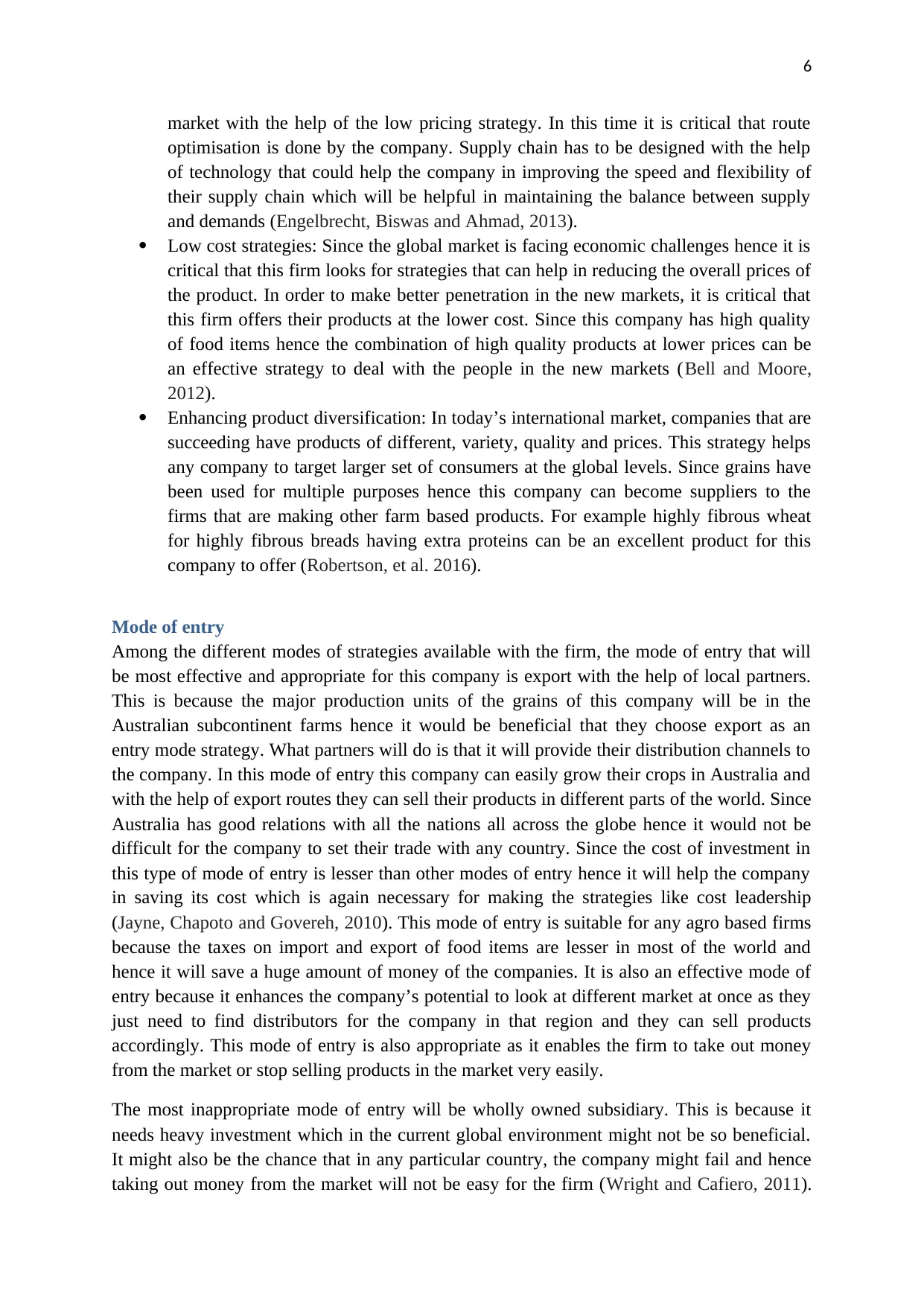
6
market with the help of the low pricing strategy. In this time it is critical that route
optimisation is done by the company. Supply chain has to be designed with the help
of technology that could help the company in improving the speed and flexibility of
their supply chain which will be helpful in maintaining the balance between supply
and demands (Engelbrecht, Biswas and Ahmad, 2013).
Low cost strategies: Since the global market is facing economic challenges hence it is
critical that this firm looks for strategies that can help in reducing the overall prices of
the product. In order to make better penetration in the new markets, it is critical that
this firm offers their products at the lower cost. Since this company has high quality
of food items hence the combination of high quality products at lower prices can be
an effective strategy to deal with the people in the new markets (Bell and Moore,
2012).
Enhancing product diversification: In today’s international market, companies that are
succeeding have products of different, variety, quality and prices. This strategy helps
any company to target larger set of consumers at the global levels. Since grains have
been used for multiple purposes hence this company can become suppliers to the
firms that are making other farm based products. For example highly fibrous wheat
for highly fibrous breads having extra proteins can be an excellent product for this
company to offer (Robertson, et al. 2016).
Mode of entry
Among the different modes of strategies available with the firm, the mode of entry that will
be most effective and appropriate for this company is export with the help of local partners.
This is because the major production units of the grains of this company will be in the
Australian subcontinent farms hence it would be beneficial that they choose export as an
entry mode strategy. What partners will do is that it will provide their distribution channels to
the company. In this mode of entry this company can easily grow their crops in Australia and
with the help of export routes they can sell their products in different parts of the world. Since
Australia has good relations with all the nations all across the globe hence it would not be
difficult for the company to set their trade with any country. Since the cost of investment in
this type of mode of entry is lesser than other modes of entry hence it will help the company
in saving its cost which is again necessary for making the strategies like cost leadership
(Jayne, Chapoto and Govereh, 2010). This mode of entry is suitable for any agro based firms
because the taxes on import and export of food items are lesser in most of the world and
hence it will save a huge amount of money of the companies. It is also an effective mode of
entry because it enhances the company’s potential to look at different market at once as they
just need to find distributors for the company in that region and they can sell products
accordingly. This mode of entry is also appropriate as it enables the firm to take out money
from the market or stop selling products in the market very easily.
The most inappropriate mode of entry will be wholly owned subsidiary. This is because it
needs heavy investment which in the current global environment might not be so beneficial.
It might also be the chance that in any particular country, the company might fail and hence
taking out money from the market will not be easy for the firm (Wright and Cafiero, 2011).
market with the help of the low pricing strategy. In this time it is critical that route
optimisation is done by the company. Supply chain has to be designed with the help
of technology that could help the company in improving the speed and flexibility of
their supply chain which will be helpful in maintaining the balance between supply
and demands (Engelbrecht, Biswas and Ahmad, 2013).
Low cost strategies: Since the global market is facing economic challenges hence it is
critical that this firm looks for strategies that can help in reducing the overall prices of
the product. In order to make better penetration in the new markets, it is critical that
this firm offers their products at the lower cost. Since this company has high quality
of food items hence the combination of high quality products at lower prices can be
an effective strategy to deal with the people in the new markets (Bell and Moore,
2012).
Enhancing product diversification: In today’s international market, companies that are
succeeding have products of different, variety, quality and prices. This strategy helps
any company to target larger set of consumers at the global levels. Since grains have
been used for multiple purposes hence this company can become suppliers to the
firms that are making other farm based products. For example highly fibrous wheat
for highly fibrous breads having extra proteins can be an excellent product for this
company to offer (Robertson, et al. 2016).
Mode of entry
Among the different modes of strategies available with the firm, the mode of entry that will
be most effective and appropriate for this company is export with the help of local partners.
This is because the major production units of the grains of this company will be in the
Australian subcontinent farms hence it would be beneficial that they choose export as an
entry mode strategy. What partners will do is that it will provide their distribution channels to
the company. In this mode of entry this company can easily grow their crops in Australia and
with the help of export routes they can sell their products in different parts of the world. Since
Australia has good relations with all the nations all across the globe hence it would not be
difficult for the company to set their trade with any country. Since the cost of investment in
this type of mode of entry is lesser than other modes of entry hence it will help the company
in saving its cost which is again necessary for making the strategies like cost leadership
(Jayne, Chapoto and Govereh, 2010). This mode of entry is suitable for any agro based firms
because the taxes on import and export of food items are lesser in most of the world and
hence it will save a huge amount of money of the companies. It is also an effective mode of
entry because it enhances the company’s potential to look at different market at once as they
just need to find distributors for the company in that region and they can sell products
accordingly. This mode of entry is also appropriate as it enables the firm to take out money
from the market or stop selling products in the market very easily.
The most inappropriate mode of entry will be wholly owned subsidiary. This is because it
needs heavy investment which in the current global environment might not be so beneficial.
It might also be the chance that in any particular country, the company might fail and hence
taking out money from the market will not be easy for the firm (Wright and Cafiero, 2011).
Paraphrase This Document
Need a fresh take? Get an instant paraphrase of this document with our AI Paraphraser
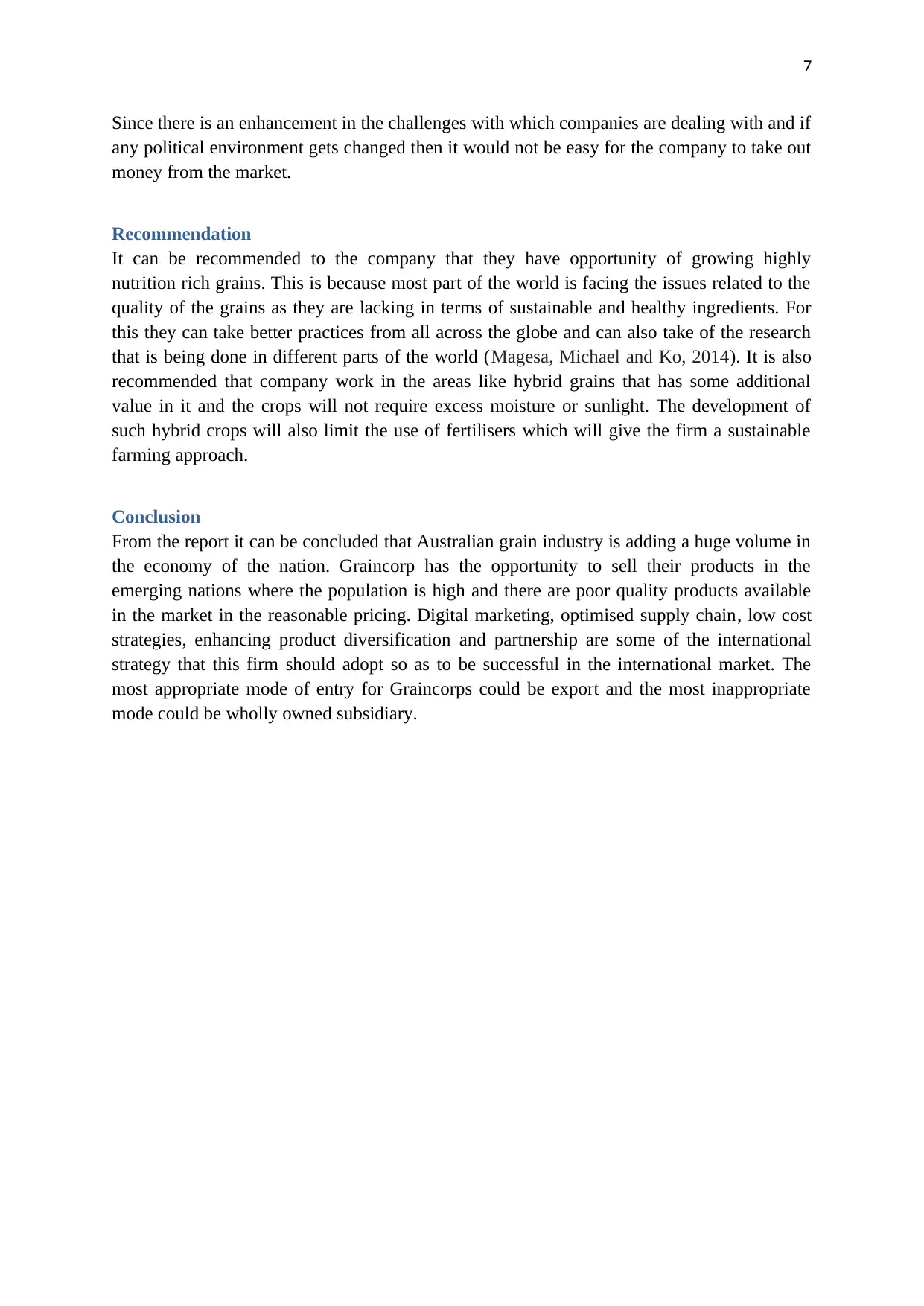
7
Since there is an enhancement in the challenges with which companies are dealing with and if
any political environment gets changed then it would not be easy for the company to take out
money from the market.
Recommendation
It can be recommended to the company that they have opportunity of growing highly
nutrition rich grains. This is because most part of the world is facing the issues related to the
quality of the grains as they are lacking in terms of sustainable and healthy ingredients. For
this they can take better practices from all across the globe and can also take of the research
that is being done in different parts of the world (Magesa, Michael and Ko, 2014). It is also
recommended that company work in the areas like hybrid grains that has some additional
value in it and the crops will not require excess moisture or sunlight. The development of
such hybrid crops will also limit the use of fertilisers which will give the firm a sustainable
farming approach.
Conclusion
From the report it can be concluded that Australian grain industry is adding a huge volume in
the economy of the nation. Graincorp has the opportunity to sell their products in the
emerging nations where the population is high and there are poor quality products available
in the market in the reasonable pricing. Digital marketing, optimised supply chain, low cost
strategies, enhancing product diversification and partnership are some of the international
strategy that this firm should adopt so as to be successful in the international market. The
most appropriate mode of entry for Graincorps could be export and the most inappropriate
mode could be wholly owned subsidiary.
Since there is an enhancement in the challenges with which companies are dealing with and if
any political environment gets changed then it would not be easy for the company to take out
money from the market.
Recommendation
It can be recommended to the company that they have opportunity of growing highly
nutrition rich grains. This is because most part of the world is facing the issues related to the
quality of the grains as they are lacking in terms of sustainable and healthy ingredients. For
this they can take better practices from all across the globe and can also take of the research
that is being done in different parts of the world (Magesa, Michael and Ko, 2014). It is also
recommended that company work in the areas like hybrid grains that has some additional
value in it and the crops will not require excess moisture or sunlight. The development of
such hybrid crops will also limit the use of fertilisers which will give the firm a sustainable
farming approach.
Conclusion
From the report it can be concluded that Australian grain industry is adding a huge volume in
the economy of the nation. Graincorp has the opportunity to sell their products in the
emerging nations where the population is high and there are poor quality products available
in the market in the reasonable pricing. Digital marketing, optimised supply chain, low cost
strategies, enhancing product diversification and partnership are some of the international
strategy that this firm should adopt so as to be successful in the international market. The
most appropriate mode of entry for Graincorps could be export and the most inappropriate
mode could be wholly owned subsidiary.
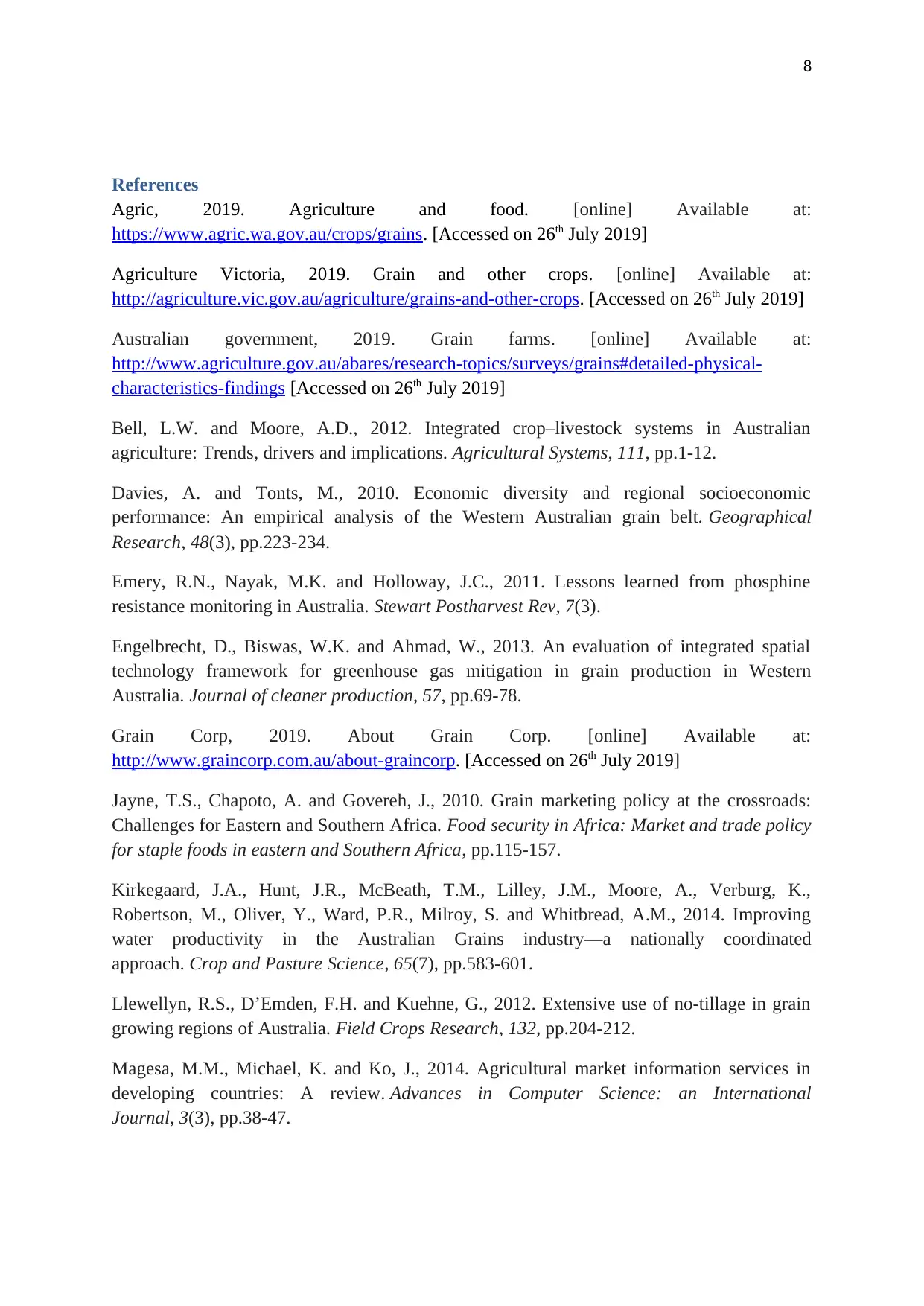
8
References
Agric, 2019. Agriculture and food. [online] Available at:
https://www.agric.wa.gov.au/crops/grains. [Accessed on 26th July 2019]
Agriculture Victoria, 2019. Grain and other crops. [online] Available at:
http://agriculture.vic.gov.au/agriculture/grains-and-other-crops. [Accessed on 26th July 2019]
Australian government, 2019. Grain farms. [online] Available at:
http://www.agriculture.gov.au/abares/research-topics/surveys/grains#detailed-physical-
characteristics-findings [Accessed on 26th July 2019]
Bell, L.W. and Moore, A.D., 2012. Integrated crop–livestock systems in Australian
agriculture: Trends, drivers and implications. Agricultural Systems, 111, pp.1-12.
Davies, A. and Tonts, M., 2010. Economic diversity and regional socioeconomic
performance: An empirical analysis of the Western Australian grain belt. Geographical
Research, 48(3), pp.223-234.
Emery, R.N., Nayak, M.K. and Holloway, J.C., 2011. Lessons learned from phosphine
resistance monitoring in Australia. Stewart Postharvest Rev, 7(3).
Engelbrecht, D., Biswas, W.K. and Ahmad, W., 2013. An evaluation of integrated spatial
technology framework for greenhouse gas mitigation in grain production in Western
Australia. Journal of cleaner production, 57, pp.69-78.
Grain Corp, 2019. About Grain Corp. [online] Available at:
http://www.graincorp.com.au/about-graincorp. [Accessed on 26th July 2019]
Jayne, T.S., Chapoto, A. and Govereh, J., 2010. Grain marketing policy at the crossroads:
Challenges for Eastern and Southern Africa. Food security in Africa: Market and trade policy
for staple foods in eastern and Southern Africa, pp.115-157.
Kirkegaard, J.A., Hunt, J.R., McBeath, T.M., Lilley, J.M., Moore, A., Verburg, K.,
Robertson, M., Oliver, Y., Ward, P.R., Milroy, S. and Whitbread, A.M., 2014. Improving
water productivity in the Australian Grains industry—a nationally coordinated
approach. Crop and Pasture Science, 65(7), pp.583-601.
Llewellyn, R.S., D’Emden, F.H. and Kuehne, G., 2012. Extensive use of no-tillage in grain
growing regions of Australia. Field Crops Research, 132, pp.204-212.
Magesa, M.M., Michael, K. and Ko, J., 2014. Agricultural market information services in
developing countries: A review. Advances in Computer Science: an International
Journal, 3(3), pp.38-47.
References
Agric, 2019. Agriculture and food. [online] Available at:
https://www.agric.wa.gov.au/crops/grains. [Accessed on 26th July 2019]
Agriculture Victoria, 2019. Grain and other crops. [online] Available at:
http://agriculture.vic.gov.au/agriculture/grains-and-other-crops. [Accessed on 26th July 2019]
Australian government, 2019. Grain farms. [online] Available at:
http://www.agriculture.gov.au/abares/research-topics/surveys/grains#detailed-physical-
characteristics-findings [Accessed on 26th July 2019]
Bell, L.W. and Moore, A.D., 2012. Integrated crop–livestock systems in Australian
agriculture: Trends, drivers and implications. Agricultural Systems, 111, pp.1-12.
Davies, A. and Tonts, M., 2010. Economic diversity and regional socioeconomic
performance: An empirical analysis of the Western Australian grain belt. Geographical
Research, 48(3), pp.223-234.
Emery, R.N., Nayak, M.K. and Holloway, J.C., 2011. Lessons learned from phosphine
resistance monitoring in Australia. Stewart Postharvest Rev, 7(3).
Engelbrecht, D., Biswas, W.K. and Ahmad, W., 2013. An evaluation of integrated spatial
technology framework for greenhouse gas mitigation in grain production in Western
Australia. Journal of cleaner production, 57, pp.69-78.
Grain Corp, 2019. About Grain Corp. [online] Available at:
http://www.graincorp.com.au/about-graincorp. [Accessed on 26th July 2019]
Jayne, T.S., Chapoto, A. and Govereh, J., 2010. Grain marketing policy at the crossroads:
Challenges for Eastern and Southern Africa. Food security in Africa: Market and trade policy
for staple foods in eastern and Southern Africa, pp.115-157.
Kirkegaard, J.A., Hunt, J.R., McBeath, T.M., Lilley, J.M., Moore, A., Verburg, K.,
Robertson, M., Oliver, Y., Ward, P.R., Milroy, S. and Whitbread, A.M., 2014. Improving
water productivity in the Australian Grains industry—a nationally coordinated
approach. Crop and Pasture Science, 65(7), pp.583-601.
Llewellyn, R.S., D’Emden, F.H. and Kuehne, G., 2012. Extensive use of no-tillage in grain
growing regions of Australia. Field Crops Research, 132, pp.204-212.
Magesa, M.M., Michael, K. and Ko, J., 2014. Agricultural market information services in
developing countries: A review. Advances in Computer Science: an International
Journal, 3(3), pp.38-47.
⊘ This is a preview!⊘
Do you want full access?
Subscribe today to unlock all pages.

Trusted by 1+ million students worldwide
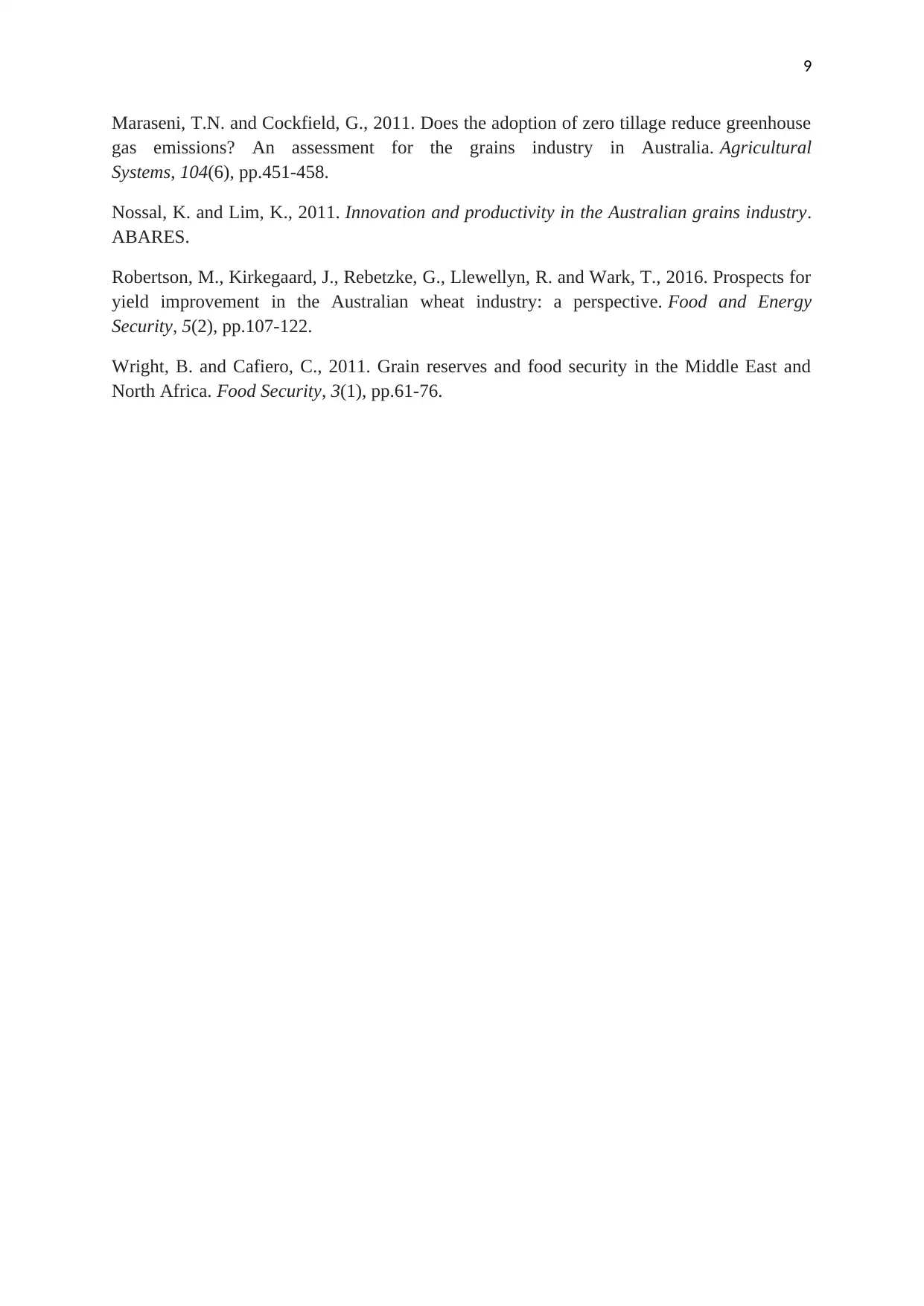
9
Maraseni, T.N. and Cockfield, G., 2011. Does the adoption of zero tillage reduce greenhouse
gas emissions? An assessment for the grains industry in Australia. Agricultural
Systems, 104(6), pp.451-458.
Nossal, K. and Lim, K., 2011. Innovation and productivity in the Australian grains industry.
ABARES.
Robertson, M., Kirkegaard, J., Rebetzke, G., Llewellyn, R. and Wark, T., 2016. Prospects for
yield improvement in the Australian wheat industry: a perspective. Food and Energy
Security, 5(2), pp.107-122.
Wright, B. and Cafiero, C., 2011. Grain reserves and food security in the Middle East and
North Africa. Food Security, 3(1), pp.61-76.
Maraseni, T.N. and Cockfield, G., 2011. Does the adoption of zero tillage reduce greenhouse
gas emissions? An assessment for the grains industry in Australia. Agricultural
Systems, 104(6), pp.451-458.
Nossal, K. and Lim, K., 2011. Innovation and productivity in the Australian grains industry.
ABARES.
Robertson, M., Kirkegaard, J., Rebetzke, G., Llewellyn, R. and Wark, T., 2016. Prospects for
yield improvement in the Australian wheat industry: a perspective. Food and Energy
Security, 5(2), pp.107-122.
Wright, B. and Cafiero, C., 2011. Grain reserves and food security in the Middle East and
North Africa. Food Security, 3(1), pp.61-76.
1 out of 10
Related Documents
Your All-in-One AI-Powered Toolkit for Academic Success.
+13062052269
info@desklib.com
Available 24*7 on WhatsApp / Email
![[object Object]](/_next/static/media/star-bottom.7253800d.svg)
Unlock your academic potential
Copyright © 2020–2025 A2Z Services. All Rights Reserved. Developed and managed by ZUCOL.





